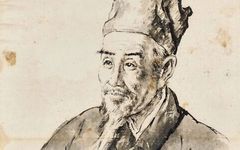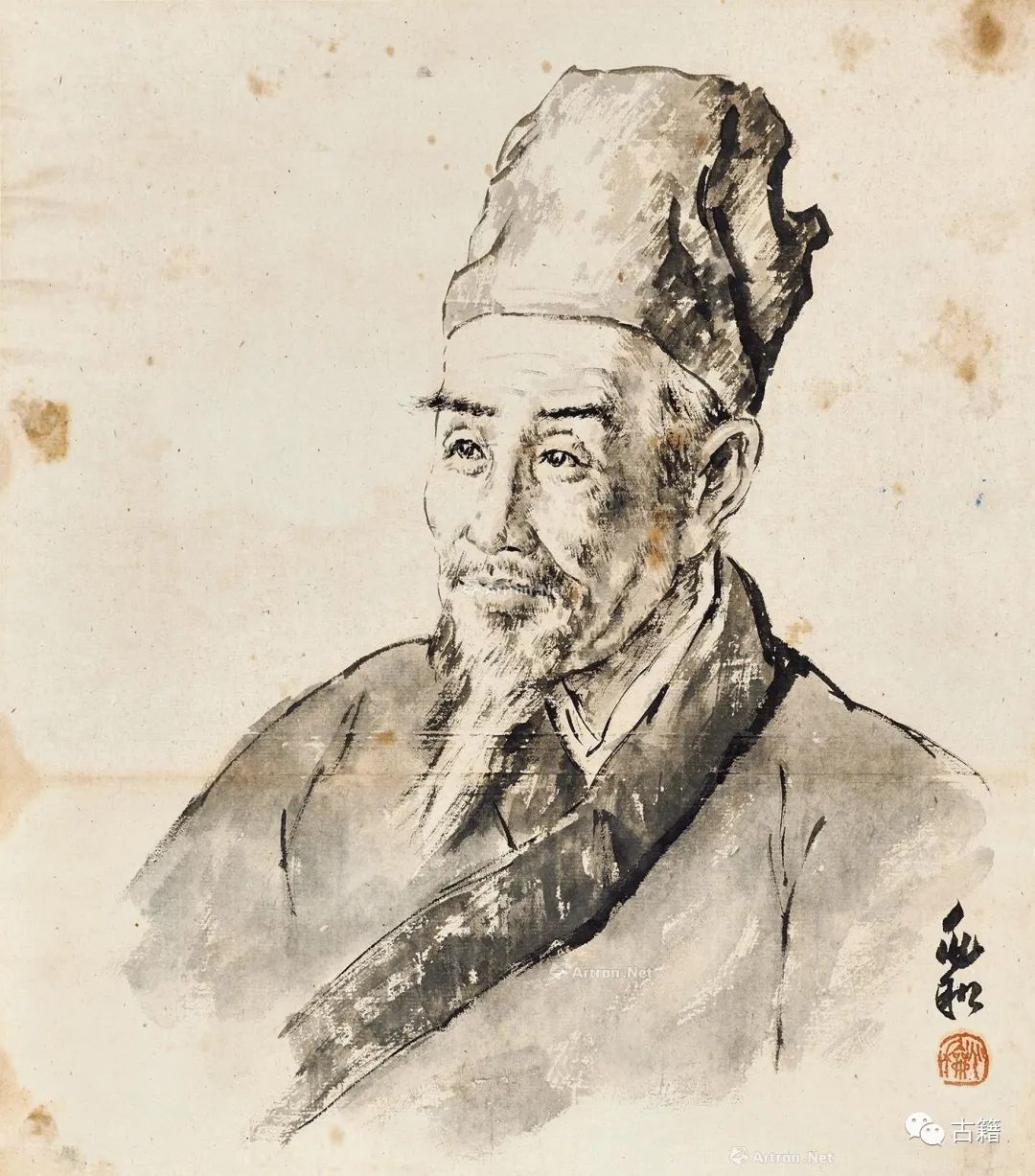
Ben Cao Gang Mu (Compendium of Materia Medica) is a monumental work in the history of Chinese herbal medicine, preserving a vast amount of lost herbal literature and serving as an important reference for future studies in TCM literature. It also improved traditional drug classification methods, making significant contributions to the advancement of natural sciences in China and the world.This article provides an overview of the life of the author of Ben Cao Gang Mu, Li Shizhen, including his biography, portrait studies, exploration of the Jinling edition, and classification system, aiming to deepen the understanding of Li Shizhen and Ben Cao Gang Mu.
Li Shizhen was a great physician and pharmacologist of the Ming Dynasty, who spent 27 years of his life compiling Ben Cao Gang Mu.Guo Moruo once summarized his great contributions to Chinese medicine as the “Saint of Medicine”.Ben Cao Gang Mu is the pinnacle of ancient Chinese herbal texts and is a highly influential comprehensive materia medica, praised as the “Great Classic of Eastern Medicine”.
Biography of Li Shizhen
In 1518, Li Shizhen was born in Qizhou, Hubei Province (now Qichun County, Hubei). His grandfather was a herbalist, and his father, Li Yanwen, was a well-known local physician who authored Qi Ai Zhuan (On Qichun Mugwort) and Ren Shen Zhuan (On Ginseng). At the age of 14, Li Shizhen passed the imperial examination and, after failing three local exams, decided to study medicine under his father.
In 1552, Li Shizhen began compiling Ben Cao Gang Mu based on Zheng Lei Ben Cao (Classified Materia Medica), referencing over 800 works. While studying various materia medica texts, he discovered errors and contradictions in previous works. To correct these mistakes and clarify doubts, he conducted extensive field research during his medical practice, traveling throughout the country. After 27 years, he completed the monumental work of approximately 1.9 million words—Ben Cao Gang Mu—in 1578.
In 1580, Li Shizhen visited the famous writer Wang Shizhen, asking him to write a preface for Ben Cao Gang Mu. After completing the manuscript, Li Shizhen traveled extensively to find a publisher, and after many difficulties, he finally found a publisher in Jinling (now Nanjing, Jiangsu Province) named Hu Chenglong in 1590. At that time, woodblock printing was still used, and it took another three years to engrave the blocks. Li Shizhen passed away in 1593, and the original edition of Ben Cao Gang Mu was published that same year.
Throughout his life, Li Shizhen experienced three stages: reading thousands of books, traveling thousands of miles, and leaving a legacy for future generations, as illustrated in Figure 1.
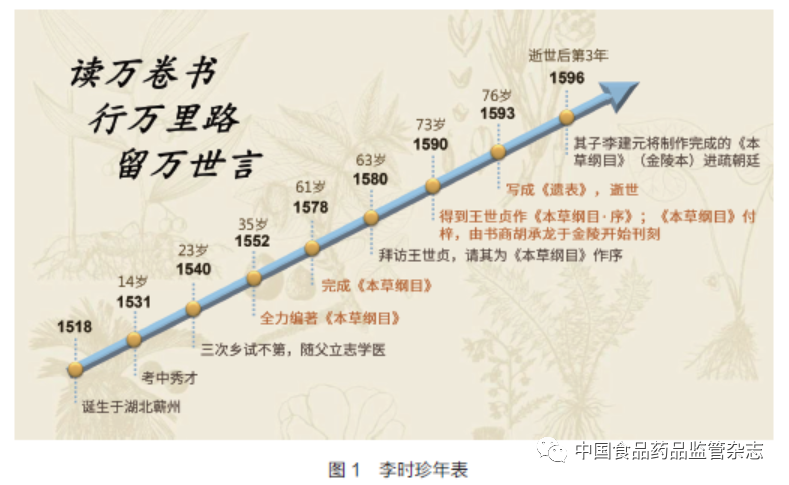 Portrait Studies of Li Shizhen
Portrait Studies of Li Shizhen
Is the portrait of Li Shizhen an accurate representation of him?
In the 1950s, when the main building of Moscow University was being constructed, they planned to include statues of world-renowned scientists and sought a portrait of Li Shizhen from China. At that time, Guo Moruo, the president of the Chinese Academy of Sciences, commissioned the famous traditional Chinese painter Jiang Zhaohe to create a portrait of Li Shizhen.
Li Shizhen left no known portrait during his lifetime. The only available description comes from Wang Shizhen, a Ming Dynasty writer and historian, who described Li Shizhen’s appearance in the preface of Ben Cao Gang Mu as “a refined appearance, a slender body, and eloquent speech.” Based on this 14-character description, Jiang Zhaohe used his father-in-law, Xiao Longyou, as a model to create the portrait of Li Shizhen (Figure 2).
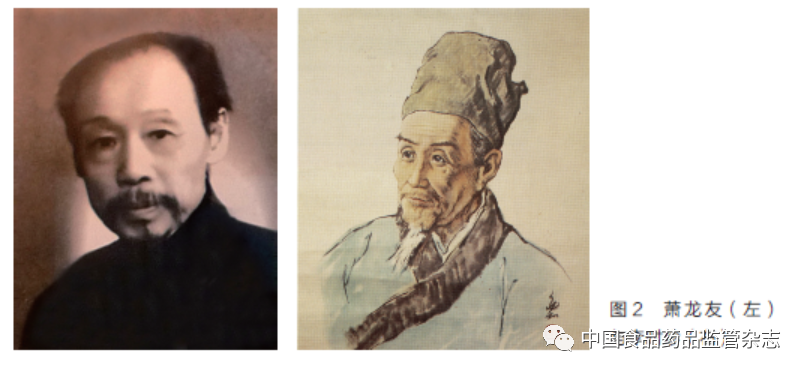
Xiao Longyou was a renowned physician, selected as a tribute scholar during the Qing Dynasty, and was known as one of the “Four Great Doctors of Beijing” alongside Shi Jinmo, Kong Bohua, and Wang Fengchun. One was a contemporary great painter, and the other a great Confucian physician, both related by marriage, contributing to the creation of Li Shizhen’s portrait, which became a celebrated story. After completion, the portrait received unanimous recognition from the public. The elderly figure depicted in the painting has a slender face and bright eyes. Since then, whether in commemorative stamps published by the state (Figure 3) or statues and images built in various places, most have used this as the standard image of Li Shizhen.

The portrait created by Jiang Zhaohe was sent to Moscow University, where local artists used it as a reference to create a mosaic portrait of Li Shizhen on the wall (Figure 4). Mosaic is an art form that originated in ancient Greece and is a traditional European artistic style that continues to this day.

In the same area, 59 other world-renowned scientists are displayed alongside him (Figure 5), including Copernicus, Galileo, Newton, Darwin, and Marie Curie, all of whom are giants in the history of science. In the hall of science, Li Shizhen stands shoulder to shoulder with other top scientists in the world, drawing attention and admiration to him, and promoting a wave of learning and research on Li Shizhen.
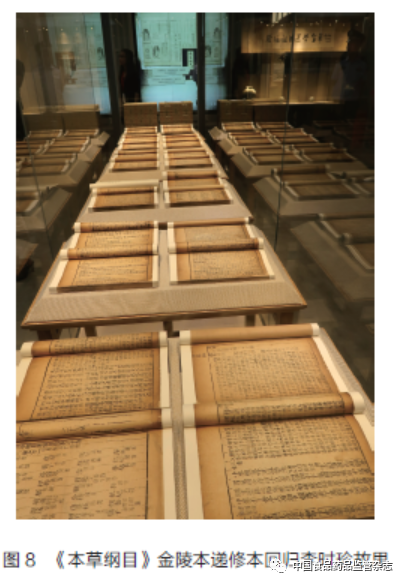
The original work sent to Moscow University has been missing for a long time. Until 1982, when the Li Shizhen Memorial Hall was being built, the curator invited Jiang Zhaohe to recreate a portrait of Li Shizhen. Thus, at the age of 80, Jiang Zhaohe, while bedridden, redrew a portrait of Li Shizhen (Figure 6) and inscribed a poem on the new portrait: “Fishermen and farmers are also my teachers, in the deep mountains gathering herbs and asking woodcutters. True knowledge and insight are not mere words, who laughs at the foolishness of revising the materia medica?”
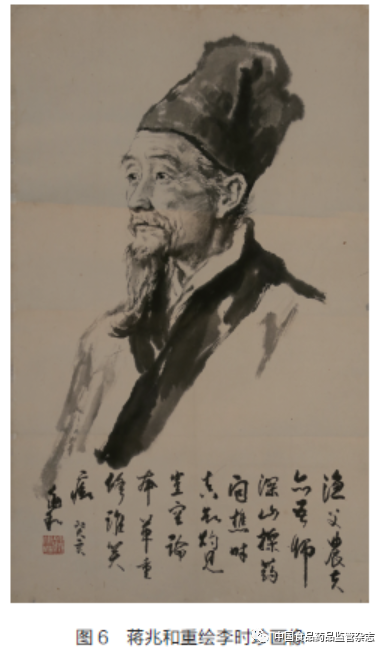 Initial Appearance of Ben Cao Gang Mu——Exploration of the Jinling Edition
Initial Appearance of Ben Cao Gang Mu——Exploration of the Jinling Edition
Since its publication, Ben Cao Gang Mu has been continuously reprinted, with over 190 editions published to date, and there are slight differences between different versions. For example, in the preface of the Ben Cao Gang Mu by Zhang Shaotang during the Qing Dynasty, Li Shizhen’s appearance is described as “zui ran mao ye” (a baby-like appearance), while the original text of the Jinling edition actually states “sui ran”. The difference between “sui” and “zui” is merely a stroke, leading to significant errors in interpretation.
Why did the Tang Dynasty monk Xuanzang endure hardships and overcome difficulties to travel to India for scriptures? The reason is that there were many copies of Buddhist scriptures in the Tang Dynasty, and each copy differed. To avoid misinterpreting the true meaning of the scriptures, Xuanzang personally traveled to India to find the authentic texts. Similarly, exploring the Jinling edition of Ben Cao Gang Mu is of great significance.
According to research, there are currently 13 complete and incomplete Jinling editions in existence, with only three in China, held by the China Academy of Chinese Medical Sciences, Shanghai Library, and private collectors. The remaining copies are mostly abroad, with nine in Japan (complete and incomplete), held in the Japanese Cabinet Library (Figure 7), Tokyo Oriental Library, National Diet Library of Japan, and Sendai Tohoku University Library; one in the United States, held by the Library of Congress.
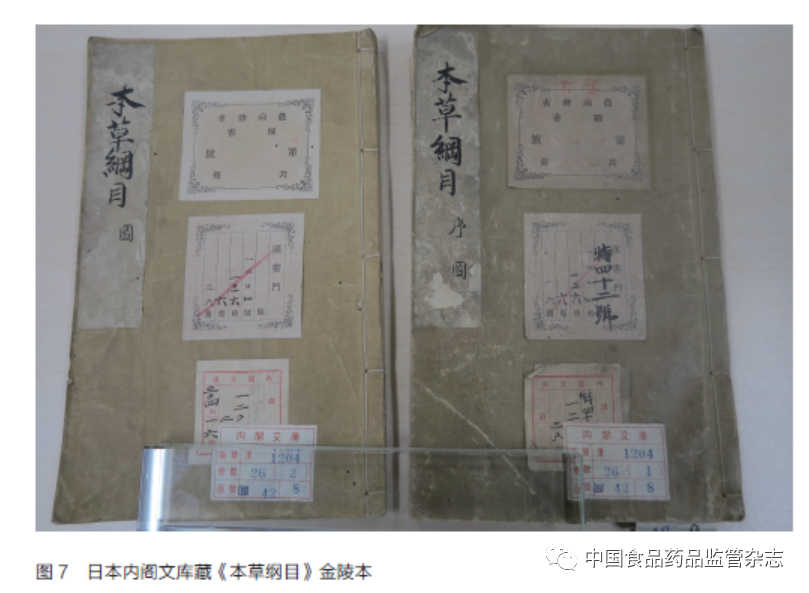
In early 2018, I traveled to Japan to explore the Jinling edition of Ben Cao Gang Mu, and the first set I examined was the one held in the Tokyo Oriental Library. This edition was collected by an Australian named George Morrison during the Republic of China period and later sold to a Japanese collector, Iwasaki, and is now housed in the Tokyo Oriental Library.
During my exploration of the Jinling edition of Ben Cao Gang Mu, I unexpectedly learned that Mr. Xing Zetian from Zhengzhou and Mr. Chao Huiyuan from Luoyang each owned a Jinling edition (Note: The version found in Luoyang was identified by Professor Zheng Jinsheng as a revised edition of the Wenjin Tang Jinling edition, not all belonging to the Jinling edition).
With the joint efforts of many, the revised Jinling edition of Ben Cao Gang Mu finally returned to Li Shizhen’s hometown in 2018, and during the celebration of Li Shizhen’s 500th birthday, the Li Shizhen Memorial Hall held a special exhibition to showcase it (Figure 8).
 Classification System of Ben Cao Gang Mu——A Comprehensive Overview
Classification System of Ben Cao Gang Mu——A Comprehensive Overview
The term “Ben Cao” in the title of Ben Cao Gang Mu clearly indicates its professional affiliation; the term “Gang Mu” highlights the characteristics of the book, which organizes and categorizes. The original meaning of “Gang” is the main rope in a fishing net, which metaphorically refers to the most important part of a matter; “Mu” refers to the holes in the net, or subdivisions within larger categories.
Ben Cao Gang Mu consists of 52 volumes, documenting 1,892 types of medicinal substances. For Li Shizhen, who aimed to catalog all known medicinal substances and produce a monumental work, the greatest challenge was how to reasonably classify nearly 2,000 types of medicinal substances.
Starting from the Shen Nong Ben Cao Jing (Shen Nong’s Classic of Materia Medica), herbal texts throughout history adopted a classification method based on human responses to medicinal substances, dividing them into three categories: superior, medium, and inferior. Superior substances are non-toxic, medium substances are mildly toxic, and inferior substances are highly toxic. From the Southern and Northern Dynasties’ Ben Cao Jing Ji Zhu to the Song Dynasty’s Zheng Lei Ben Cao, there were no significant breakthroughs in drug classification methods. Although Ben Cao Jing Ji Zhu was the first to classify drugs based on their natural properties into seven categories: jade and stone, herbs, wood, insects and beasts, fruits and vegetables, grains, and unnamed substances, and Zheng Lei Ben Cao divided drugs into 11 categories: jade, herbs, wood, human, beast, bird, insect, fish, fruit, grains, and unnamed substances, the underlying classification continued to follow the three-tier system, presenting a coexistence of natural property classification and three-tier classification.
It was not until the Ming Dynasty’s Ben Cao Gang Mu that the three-tier classification method was completely abandoned, adopting a method of family and category classification, dividing drugs into 16 categories: water, fire, earth, metal and stone, herbs, grains, vegetables, fruits, wood, utensils, insects, scales, shells, birds, beasts, and humans, with each category further classified according to the ecological and property characteristics of the drugs, totaling 60 types. This was summarized in a four-line mnemonic: water, fire, earth, metal and stone; herbs, wood, fruits, and grains; utensils, insects, scales, and shells; birds, beasts, and humans (Figure 9).
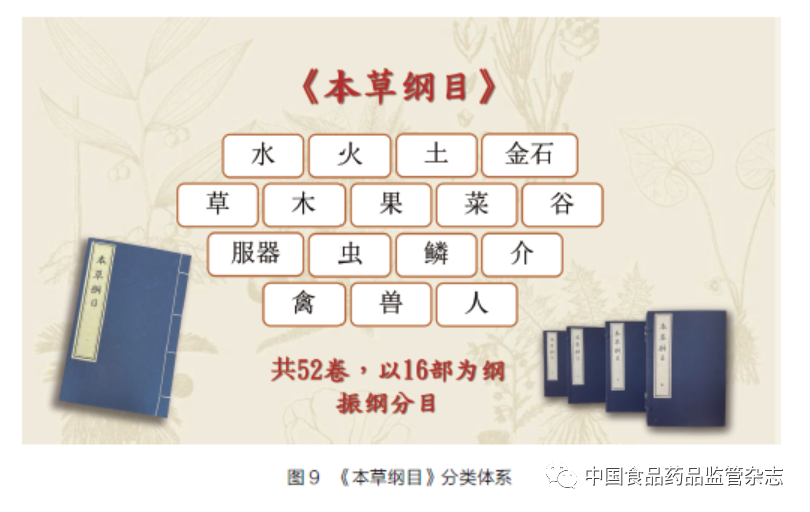
The fire category was the first addition by Li Shizhen.
The earth and metal and stone categories correspond to modern mineral medicines.
The herb, grain, vegetable, and fruit categories are the core of Ben Cao Gang Mu, occupying the largest portion of the text, approximately half of the entire book (Figure 10).
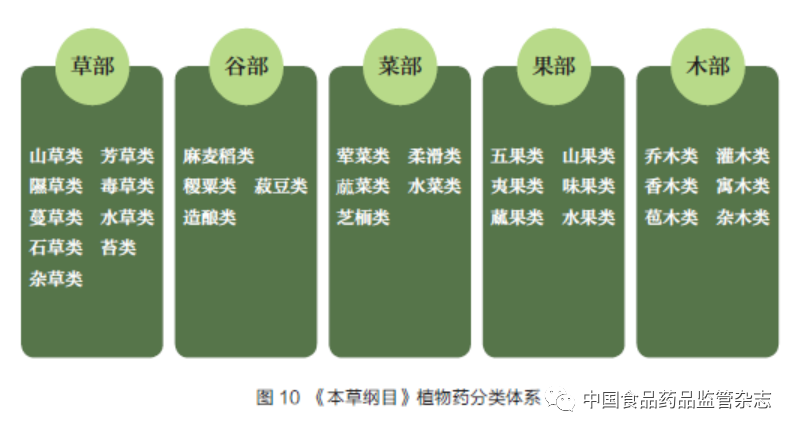
The herb category consists of 10 types. Among them, the mountain herbs are mainly wild varieties that grow in mountainous areas, most of which are commonly used medicinal substances recorded in the Shen Nong Ben Cao Jing, such as ginseng, licorice, astragalus, and coptis. The aromatic herbs mostly include aromatic medicinal plants, many of which are famous flowers, such as peony, jasmine, and rosemary. The lowland herbs can grow in plains and can also be cultivated in fields, such as chrysanthemum, mugwort, and Qinghao (Artemisia annua). The toxic herbs include rhubarb and tian nanxing (Arisaema).
The wood category includes pine and cypress, as well as agarwood, sandalwood, and incense, and includes the use of bark from Eucommia, magnolia, and phellodendron, as well as resins like frankincense and myrrh, and also includes plants that can be used as both medicine and pigment, such as gardenia and lacquer tree. Among the wood category, the parasitic plants include various types of mistletoe, and also include Poria, which resides under pine trees.
The grain, vegetable, and fruit categories contain a large number of food ingredients, most of which are also medicinal foods. They include various grains, scallions, ginger, garlic, soy sauce, vinegar, cabbage, radishes, melons, peaches, and dried and fresh fruits, which have been selected over thousands of years from thousands of plants and are indispensable medicinal plants.
The utensils category includes two types: utensils and objects, with most recorded uses being folk remedies. For example, clothing worn by patients with infectious diseases can be boiled before wearing to prevent infection, which is akin to an ancient method of sterilization. The application of silk and satin is related to health, reflecting the living standards, technological levels, and craftsmanship of the Ming Dynasty to some extent.
The insect category includes bees, galls, toads, geckos, and earthworms.
The scale and shell categories include many marine medicines, such as pearls and oysters.
Overall, the arrangement of Ben Cao Gang Mu reflects the principles of classification from inorganic to organic substances, from lower to higher organisms, always adhering to the principle of ordering from cheap to valuable. Understanding this principle makes it easier to grasp the main ideas of Ben Cao Gang Mu, where the outline contains the details, broad yet not cumbersome, detailed yet essential.
Conclusion
Ben Cao Gang Mu can be regarded as the culmination of traditional Chinese medicine before the Ming Dynasty. It is a monumental work compiled by Li Shizhen over several decades, based on the inheritance and summarization of previous achievements in materia medica, combined with his extensive firsthand clinical experience and field research. The book broke the long-standing three-tier classification system that had been in place for over a thousand years and established a systematic classification based on the natural properties of medicinal substances, predating Linnaeus’s Systema Naturae by a century and a half. Ben Cao Gang Mu not only made outstanding contributions to the development of pharmacology in China but also had a profound impact on the development of medicine, botany, and other disciplines worldwide, being praised by Darwin as the “Encyclopedia of Ancient China”.
Author’s Biography:Zhao Zhongzhen, Ph.D., is the founding director of the Ben Cao Gang Mu Research Institute at Beijing University of Chinese Medicine.Specialization:Research in pharmacognosy and world traditional medicine.

